Ник на форуме: NimbusPlatform230410847
Nimbus, leading provider of client portal solutions for consultancies, is thrilled to announce its strategic evolution into FuseBase. This rebrand embodies the company’s focus on pioneering the next stage of consultant-to-client collaboration.
“As Nimbus, we established an industry-leading position in frictionless client portals tailored to consultancies. As FuseBase, we are broadening our vision to fuse together every capability consultants need to propel collaboration to new heights,” said CEO Pavel Sher.
The new FuseBase brand represents the blended power of project management, file sharing, analytics, and content workflows into one seamless platform. This symbiotic fusion empowers consultancies to unlock new levels of productivity, profitability, and client satisfaction.
With an exciting new brand identity, FuseBase stands ready to fuse potential into performance for forward-thinking consultancies across the globe. The fusion has just begun.
Knowledge is power in today's world, and knowledge sharing is a critical component of any organization's success. It allows for the free flow of information and ideas between employees, leading to increased productivity, innovation, and overall performance. This article will explore the best practices of knowledge sharing and management in an organization and the benefits it can bring. First, we will discuss how a culture of collaboration and teamwork can be fostered through knowledge sharing. Next, we will look at how technology can be utilized to improve communication and productivity. We will also overview the steps for implementing a successful knowledge-sharing system and strategies for measuring its effectiveness. Ultimately, this article aims to highlight the importance of knowledge sharing and its potential to drive organizational success as well as reveal the best practices for building a strong knowledge-sharing and knowledge-creation culture within a team or organization.
Knowledge sharing refers to the process of sharing valuable information, experiences, and expertise among team members. This can take place in a variety of ways, including formal training programs, informal conversations, and mentoring, as well as the use of technology, for example, collaboration tools. Knowledge sharing aims to make the most of the collective knowledge within an organization so that employees can work more effectively and efficiently and the organization can achieve its goals.
Knowledge sharing best practices help organizations create a knowledge-based culture, where the employees feel encouraged to share their knowledge and learn from their peers. This kind of company culture allows for the flow of information and ideas between team members, increasing productivity, innovation, and better performance. Additionally, knowledge-management activities providing employees with the capability to learn from one another can help them improve their skills and advance their careers.
There are various types of knowledge that can be shared in an organization, such as technical knowledge, business knowledge, and effective practices. Overall, knowledge sharing is a vital activity that can help organizations to achieve their goals and remain competitive in today's fast-paced business environment.
Knowledge sharing is vital for the success of an organization as it allows for the flow of information and ideas between employees and helps in creating a culture of collaboration and teamwork, improving communication and decision-making, enhancing learning and development, and strengthening relationships and trust.
When new hires have instant access to the knowledge and resources they need, they can work more efficiently from day one.
Sharing knowledge allows for the exchange of new ideas and perspectives, which can lead to breakthroughs and innovation and prevent the loss of valuable knowledge and expertise, known as brain drain.
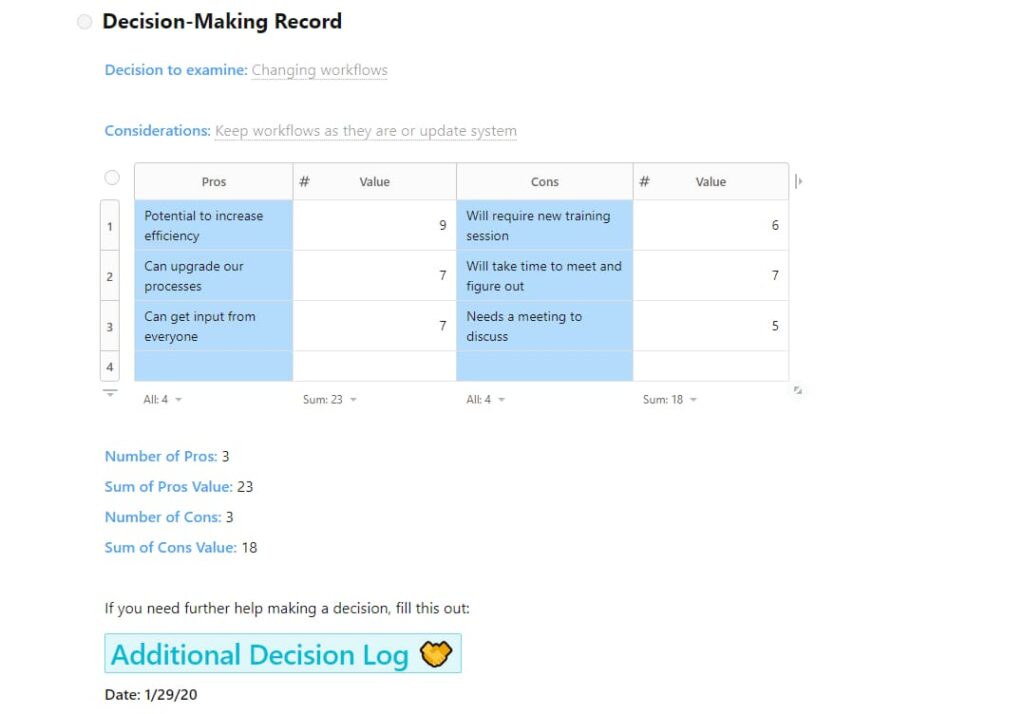
When a team member engages in gathering information from subject matter experts, they can make more informed and accurate decisions.
Knowledge sharing habits allow employees to learn from each other, which can help them improve their skills and advance their careers.
When team members exchange their knowledge and experiences, they can more easily identify and solve problems, as well as fill in knowledge gaps and stay updated with the latest trends and best practices in their field.
By transferring knowledge and information, not only experienced employees but also new hires, can build stronger relationships and promote psychological safety.
Organizations that effectively share knowledge are better equipped to adapt to real-world problems and changes, and thus remain competitive in the marketplace.
Knowledge exchange among team members can lead to a better understanding of customer needs and more effective service.
By sharing knowledge, organizations can reduce the time and resources required to acquire new information and also benefit from the proficiency of experienced workers.
When employees spend time sharing knowledge during team meetings, it leads to a stronger sense of team cohesion and better access to the expertise and skills of the entire team.
Building a shared knowledge culture in an organization involves creating an environment where employees, including remote workers, feel encouraged and empowered to work together and share knowledge. This can be achieved through various means - let’s overview the best practices and methods of knowledge sharing.
1. Encouraging open internal communication: Creating channels for employees to share ideas, ask questions, and provide feedback can help to promote a knowledge-sharing culture.
2. Fostering teamwork: By encouraging employees to work together on projects and initiatives, organizations can build a culture of collaboration.
3. Rewarding collaboration and giving public recognition: By recognizing and rewarding employees for working together effectively, organizations can encourage more collaboration.
4. Providing opportunities for learning and development: Offering training and development opportunities and disseminating lessons learned from past projects, employers help their employees improve their skills and avoid the same mistakes, and, as a result, work more effectively.
5. Promoting a positive work environment: Organizations can encourage team members to collaborate and share knowledge by creating a positive and supportive work environment.
6. Implementing a knowledge management system: Having a central hub where employees can share and access knowledge can promote a culture of collaboration and make sharing knowledge easier.
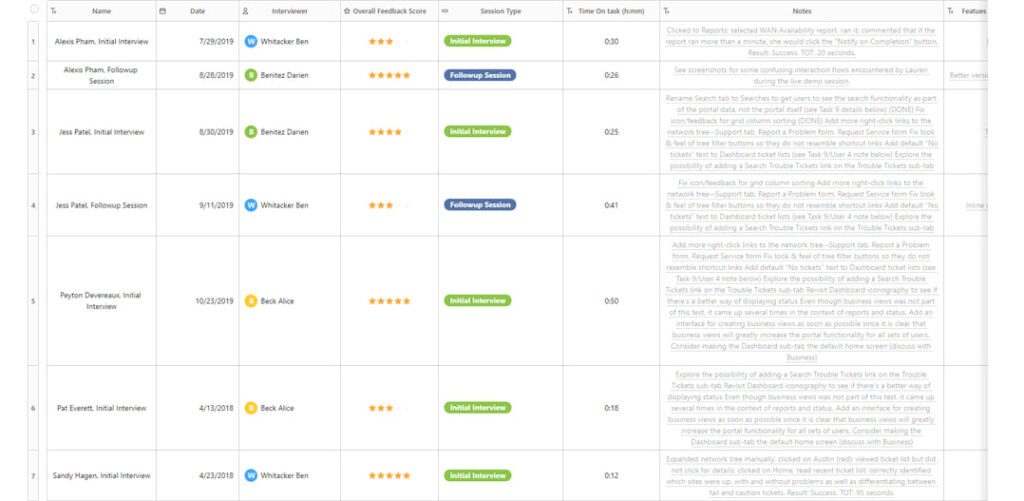
7. Encouraging diversity and inclusivity: By valuing diversity and creating an inclusive environment, organizations can promote an organization's culture where different perspectives and ideas are valued.
8. Lead by example: Managers and leaders play a crucial role in setting an example for collaboration and encouraging other employees to work together.
Creating a knowledge-sharing culture can help companies achieve their goals by leveraging the collective knowledge and expertise of employees.
Technology plays a significant role in building knowledge sharing by providing tools and platforms for creating, organizing, and disseminating valuable information. Examples include online collaboration tools such as Google Docs, Slack, Nimbus Platform, knowledge management systems like Confluence and SharePoint, social media platforms like LinkedIn and Twitter, and knowledge bases or knowledge-storage systems like Zendesk and Document360. These tools make it easier for individuals and different teams to share information, collaborate on projects, and access a wide range of resources. Overall, technology is a key enabler of knowledge hoarding, knowledge sharing and collaboration, and organizations that adopt both knowledge sharing best practices and the appropriate technology will be more capable of reaching their objectives.
The Nimbus Platform is a cloud-based knowledge management system with dedicated space for storing knowledge that can be used to facilitate knowledge storage sharing within an organization.
Empower your company's knowledge sharing with Nimbus Platform™!
One feature of the Nimbus platform that stands out and should be mentioned in the context of knowledge management is the Nimbus knowledge base. This allows users to store and organize a wide variety of content, such as articles, procedures, FAQs, and best practices, and is valuable for organizations looking to improve their knowledge sharing and collaboration efforts. Knowledge bases can be used for internal teams, customer self-service, and also as public-facing knowledge portals.
Implementing a knowledge-sharing system can be a complex process, but it can be broken down into several key steps:
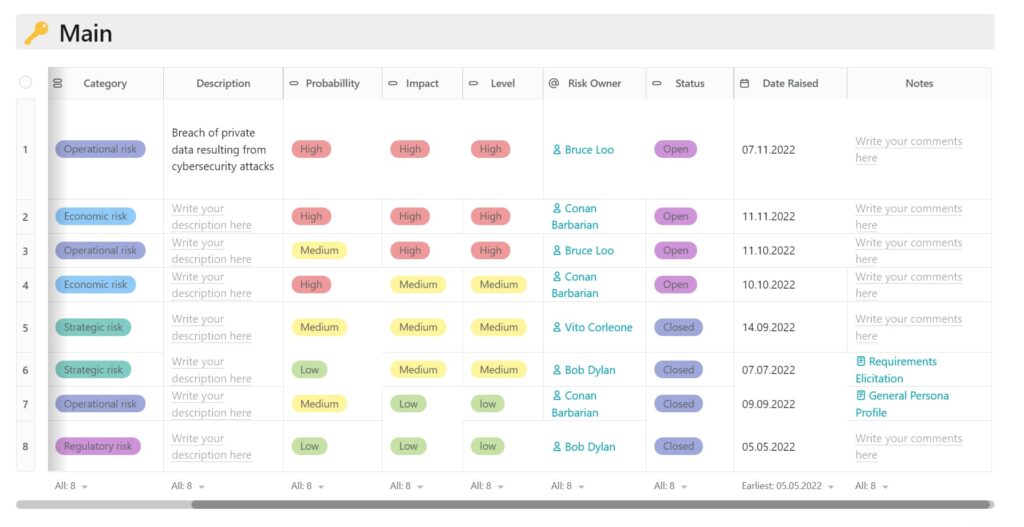
Measuring the business success of knowledge sharing in an organization can be challenging, but several key metrics can be used to evaluate the effectiveness of a knowledge sharing strategy:
By monitoring these metrics of knowledge-sharing activities, organizations can gain insight into the effectiveness of their knowledge sharing methods and strategy and make adjustments to improve their performance.
In today's fast-paced business environment, knowledge is a business' most important asset. Thus, knowledge sharing is more important than ever. Organizations that are able to effectively share important knowledge and collaborate are better prepared to innovate, make more balanced decisions, and stay competitive. The best practices for knowledge sharing involve the wide usage of relevant knowledge management tools, such as Nimbus Platform, providing a range of advanced tools to help organizations achieve their knowledge sharing and collaboration goals. Nimbus Super documents, Nimbus Note, Nimbus Capture, and other powerful features and mini-tools will allow you to streamline the document management process and improve teamwork with minimal costs. Building an effective knowledge-sharing system has never been easier!
Visit the Nimbus Twitter page for the latest news and updates!
Read more about best knowledge sharing practices here.
In today's fast-paced world, information is power and a well-built knowledge base is the ultimate weapon in the quest for knowledge. Wow, that came out like an epic movie trailer! But bear with us, because things get even better… Whether you're a business looking to streamline customer support or an individual looking to expand your horizons, knowledge bases have something to offer for everyone. So, fasten your seatbelt and prepare to take a journey through the exciting world of knowledge base examples. By the end of this journey, you will feel smarter and more efficient than ever before!
Still wondering what a knowledge base is? Look no further, our friend. A knowledge base is a collection of information that is organized and structured in a way that makes it easy to find and retrieve. This information can be in the form of text, images, videos, or other types of media. The goal of a knowledge base is to provide users (customers or employees, for instance) with easy access to the information they need to complete a task or answer a question.

One of the most common uses of a knowledge base is in customer service, where it can be used to provide both your customers and your potential customers with answers to frequently asked questions (FAQ). Knowledge bases can also be used in other areas such as technical support, training, and research. They can be hosted on a company's website, or as a standalone software application and can be accessed by users through search functionality or by browsing through categories and subcategories.
As we have explored in previous articles about knowledge bases, there are tons of benefits to implementing a knowledge base in your business, but we believe that the most prominent ones are these two:
So, with these two benefits in mind, as Chandler Bing would say, could knowledge bases be any more awesome?!
So now that we know how awesome a knowledge base can be, let’s talk about what makes a good knowledge base example, that is, what features a knowledge base software needs to have so that it provides a great user experience and all the benefits discussed above. In our professional opinion, knowledge bases need to have the following:
Let’s now take a look at 10 knowledge bases you can find online which are great examples, each in their own way and for different reasons.
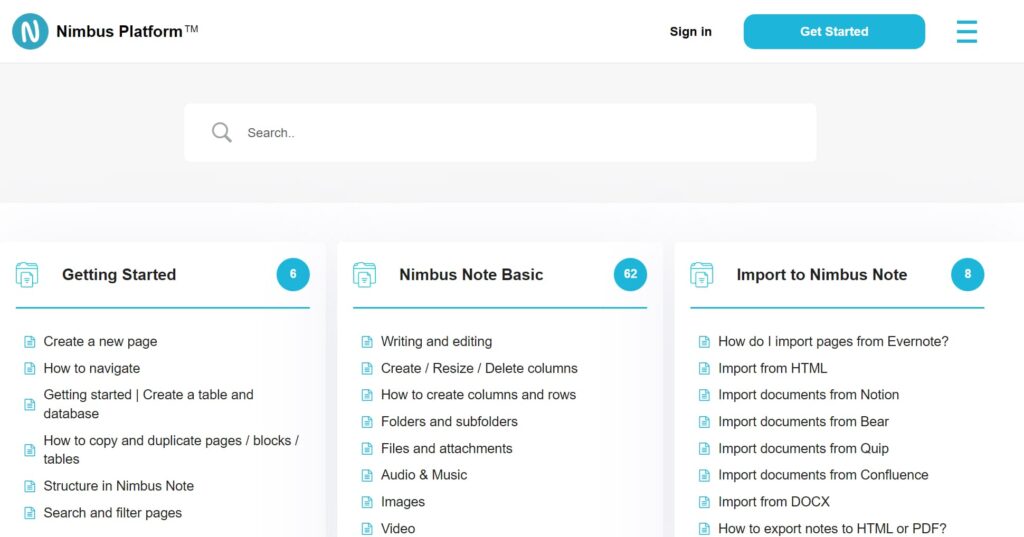
This knowledge base example contains a large number of support articles and vast amounts of information, yet its UI’s look and feel makes it visually pleasant. Also, the articles’ layout, with a search box and a complete sidebar and table of contents, provides users with a wonderful browsing experience. And last but not least, at the end of each knowledge base article, if you haven’t found the answer to your query yet, there’s a direct link to open a ticket and get direct support from the Nimbus team, providing that personal touch that some help centers tend to lack.
Why we like it:
Key lessons:
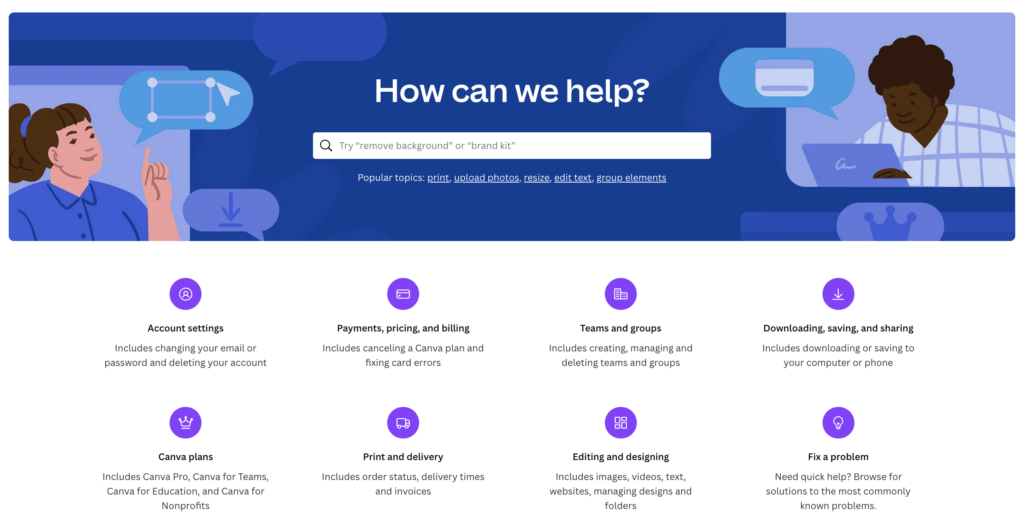
Canva’s help center is one of the best knowledge base examples. Not only does it provide a comprehensive list of topics and other resources to help you with your designs, it also features an interactive search bar that allows you to quickly find the content you’re looking for. Their support articles offer concise yet detailed instant answers to common questions users have, as well as helpful internal links to additional resources.
Why we like it:
Key lessons:
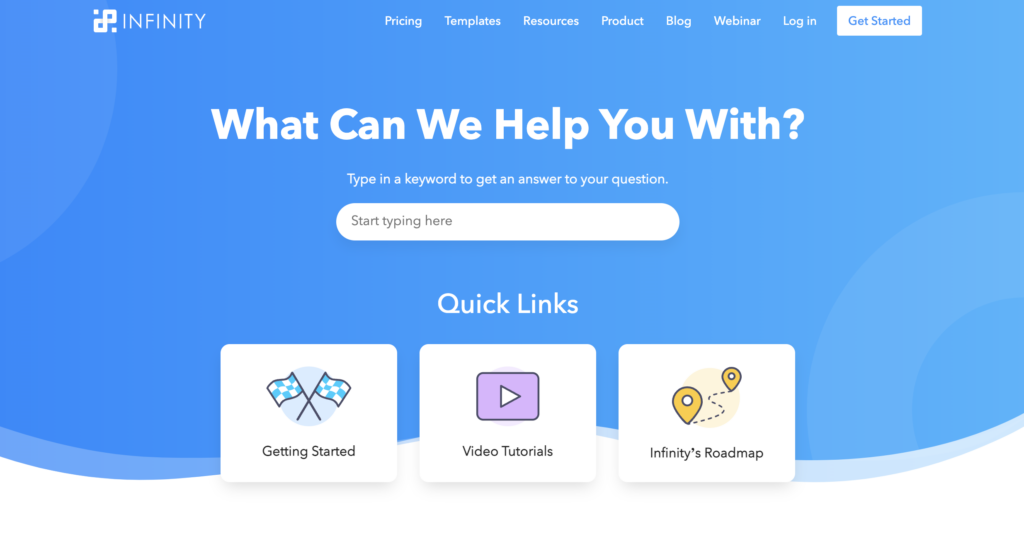
Our colleagues at Infinity have done a great job with their support knowledge base. With their lovely design and well-organized support page, they have created a comprehensive knowledge base for their users, with articles enriched with static images, GIFs, videos, etc. Furthermore, their interactive search bar is present not only on the knowledge base homepage, but also inside each article, which saves time having to go back and forth. These knowledge base articles also link to next/previous articles at the end and have a left sidebar to related support categories.
Why we like it:
Key lessons:
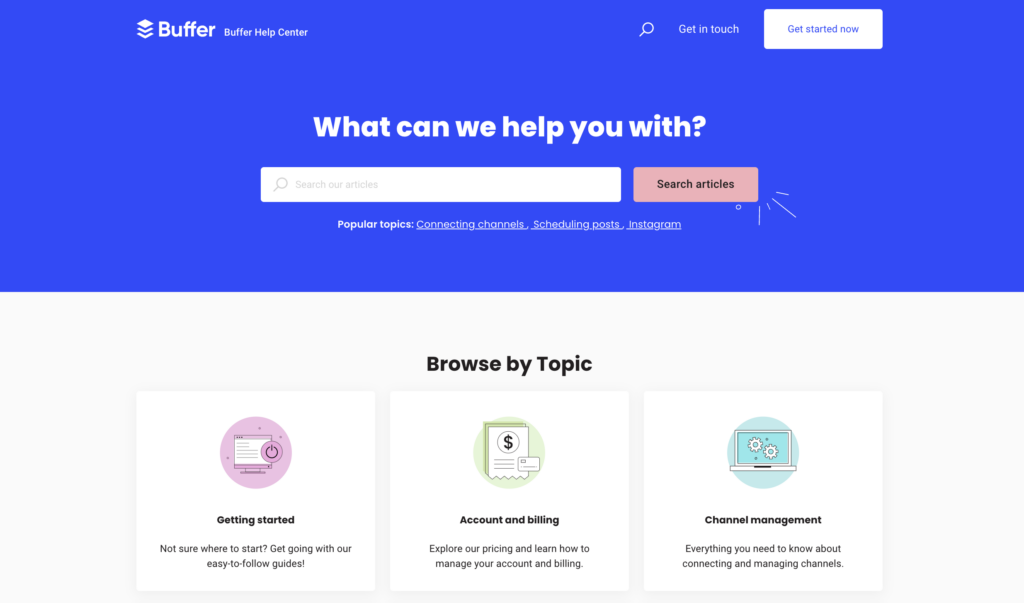
This social media scheduler does a hell of a job providing its users with a useful, self-service resource and help center. With a simple yet colorful design, Buffer’s knowledge base has a clear, easy-to-navigate interface, despite containing a considerable number of articles. And we think it’s a great knowledge base example.
Why we like it:
Key lessons:
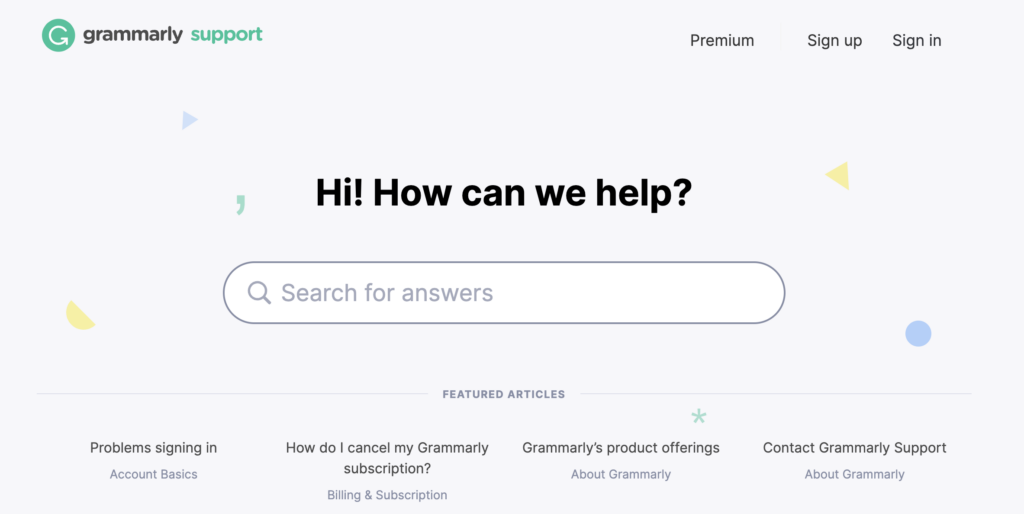
Grammarly does a wonderful job supporting its users thanks to its knowledge base. Its on-brand minimalistic design facilitates browsing the hundreds of articles contained in this knowledge base example which, at the same time, rakes in tens of thousands of organic visits from search engines. Furthermore, their main support page is a breath of fresh air, which they achieve by offering only a few clickable elements: search bar, four featured articles and six support categories. That’s it.
Why we like it:
Key lessons:
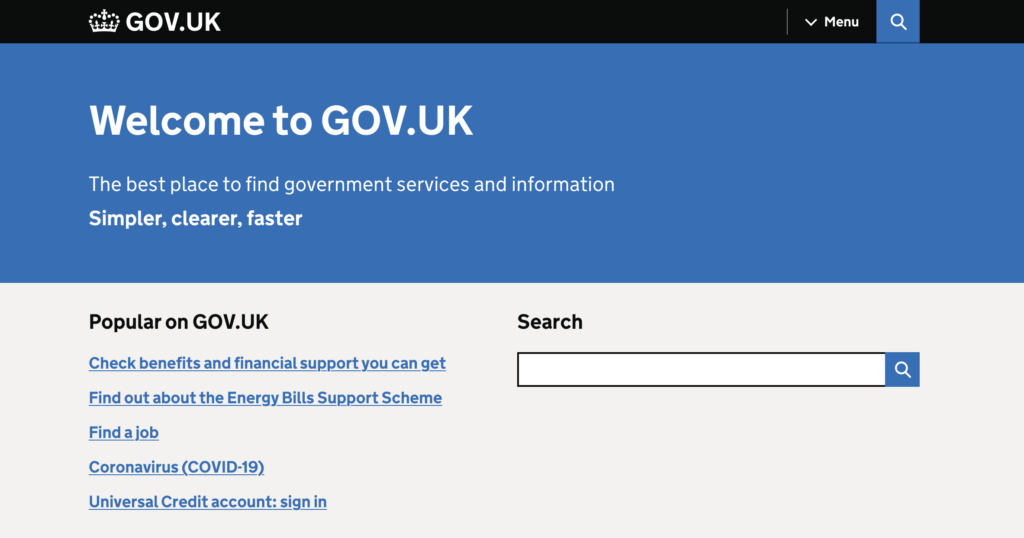
Creating a support center for a whole country is no mean feat, that’s for sure. And although some improvements should probably be implemented, we believe the UK’s government website is one of the best knowledge base examples to show how knowledge bases act or should work when they’re used in national entities to support citizens.
Why we like it:
Key lessons:
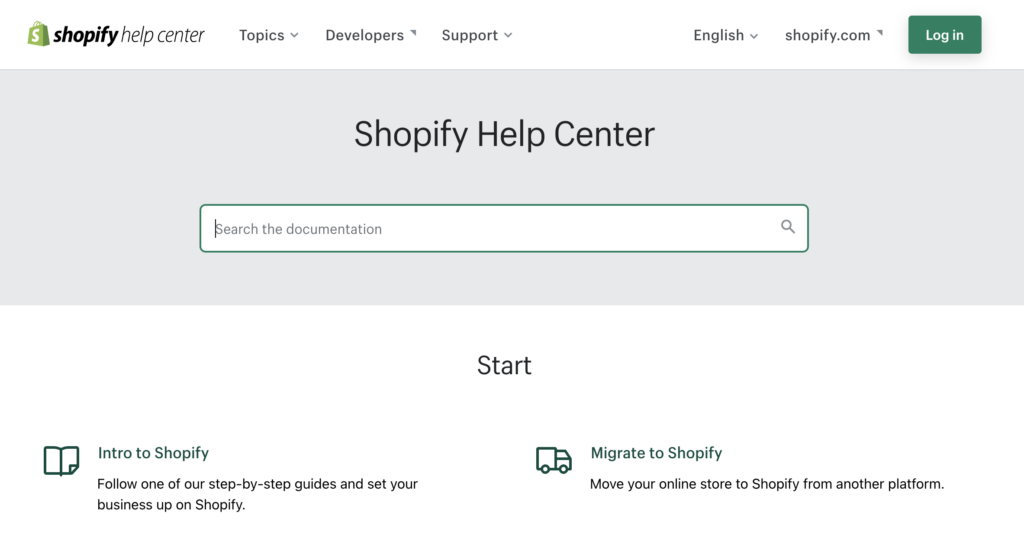
Shopify's help center is a one-stop shop (pun intended!) for individuals and businesses looking to create and manage their online stores. This customer knowledge base example offers a wide range of articles, tutorials and guides on various complex topics like setting up a store, designing and customizing it, managing inventory, processing payments, and shipping orders. One of the things that stands out is that the help center also links to a community forum where users can ask questions and share tips and advice with other Shopify users.
Key lessons:
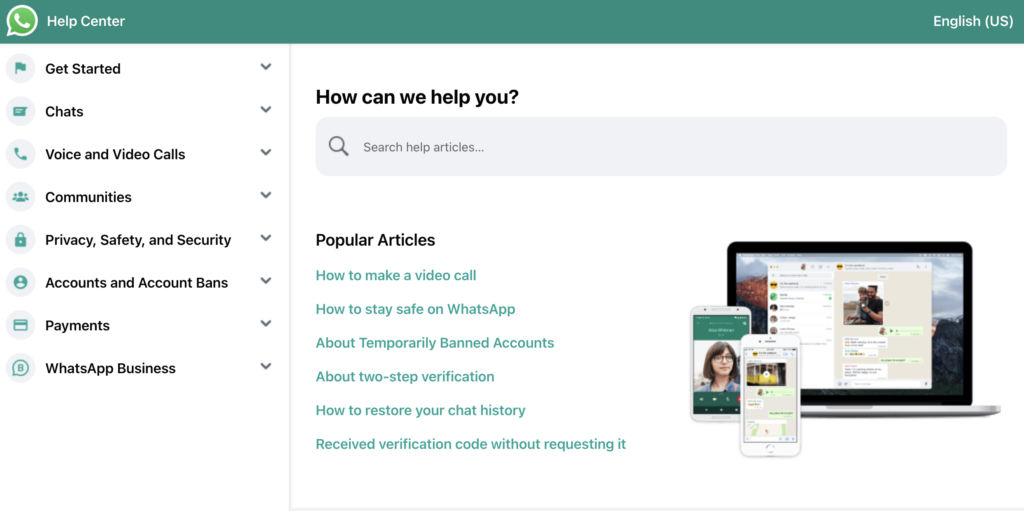
WhatsApp's help center is a user-friendly resource for individuals looking to learn more about using this popular instant messaging app. This knowledge base example offers a wide range of articles, tutorials and guides on various topics such as account setup, security, privacy, and troubleshooting. One of the interesting things about this knowledge base is that users can also access the help center through the app itself, making it easily accessible and searchable.
Why we like it:
Key lessons:
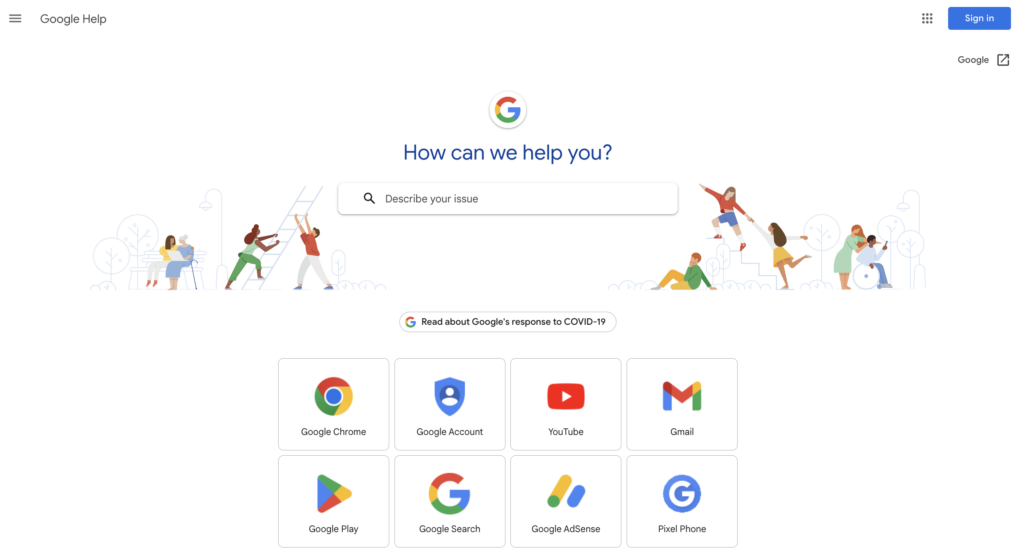
Google.com is the most visited website in the world, which is not surprising nowadays. So how do you create a knowledge base for the most popular site online? We think Google has done a good job out of it. First, given how many products and services they have, they list all of these using their characteristic icon logos, which makes it easier for users to know where to go. And once you access one of these products, you get a list of accordion tabs listing all the subcategories and support articles. We believe it’s a good way to structure such an amount of relevant information. And just like Shopify, some of their sections link to online communities where users can help each other.
Why we like it:
Key lessons:
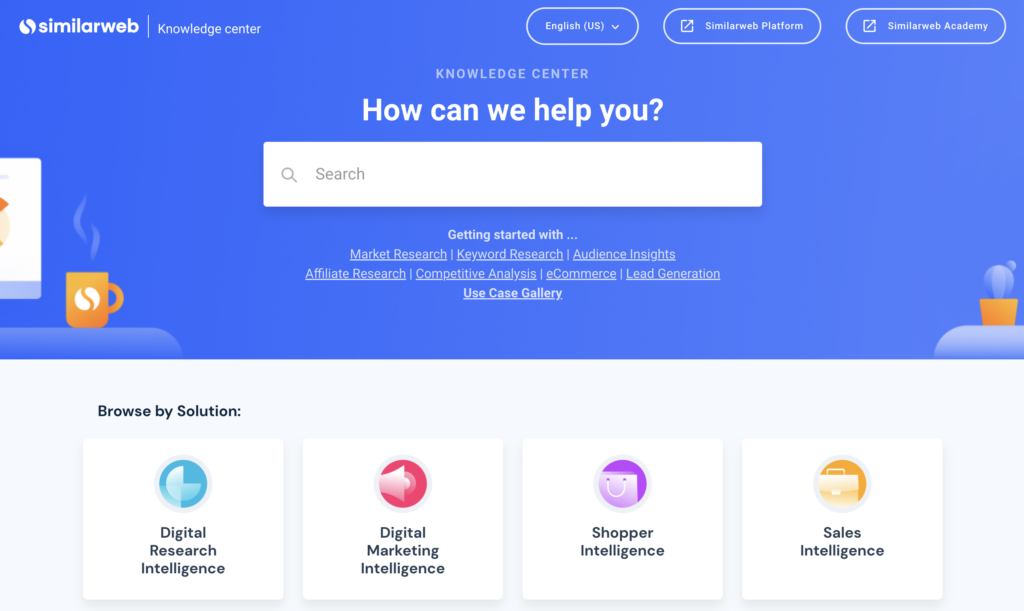
The popular online marketing platform features another great knowledge base example. In fact, it might be one of the best knowledge bases we have come across. Apart from having a perfectly branded help center, this knowledge base allows visitors to browse by solution, as Similarweb offers different products, or by topic. One thing that stands out and that we haven’t seen in other customer knowledge bases is the presence of a glossary, which can be quite useful not only to help users understand key terms, but also for SEO purposes, as a well-thought and carefully written glossary can attract a considerable amount organic traffic.
Why we like it:
Key lessons:
Nimbus Platform and, more specifically, Nimbus Note provides you with the necessary tools to create a great knowledge base. Whether you need internal knowledge bases for your staff or an external knowledge base for your clients or users, with Nimbus Note you can create any type of support article which you can enrich with images, videos, call-out boxes, accordions, embeds, etc. And it can be used as well as a project management software which integrates seamlessly with your knowledge base.
Spoiler alert: it’s so much better than Google Docs!
Furthermore, you can also use Nimbus Capture and Nimbus Clipper to incorporate screenshots, video recordings and text snippets from the web. Besides, Nimbus Note’s nested folders and linking capabilities make it easy to organize and categorize support articles in the best possible way for your users.
Organize an effective knowledge base for your business with Nimbus Platform™!
In conclusion, an effective knowledge base is like a well-stocked toolbox – it gives you the tools you need to tackle any problem that comes your way (Okay, Ryan? Go solve your own problems, buddy!). Whether you're looking for a comprehensive guide to a particular topic, or simply need a quick answer to a specific question, a well-designed knowledge base can be an invaluable resource. So if you're a business looking to improve customer service or your support team, it's worth taking the time to explore some of the excellent knowledge base examples we’ve listed in this article.
Originally it was posted here: Nimbus Platform.
Follow Nimbus Platform on Linkedin for the latest articles and updates!
“I love spending all my waking hours sending emails to my clients”, said no one ever. We’re sure you can relate. How many times have your clients “lost” emails with important files (a.k.a. pending invoices)? Far too many, right? Well, that ends today! If clients want to play dumb with us, we will become client management wizards, or shall we say… Dumb-ledores? (wink, wink) And the best way to do that is to use client portals.
Client portals, though not the mystical kind of portal (shame!), allow you to manage the flow of information and communication between you and your clients. And since there are so many options out there to get lost in, in this article, we'll explore the best client portal software you should be considering in 2023, so you can find the perfect match for your business needs and keep They-Who-Shall-Not-Be-Named happy.
A client portal is an online environment designed to provide a secure and convenient way for clients and customers to access information, manage and share files, and communicate with you and your business. To continue with the Harry Potter analogy, a client portal is like Gringotts Bank for business communication; it serves as a secure vault to store and manage information and interactions between clients and service providers (a.k.a. you).
In today's digital age, a client portal has become an essential tool for businesses to improve customer engagement, increase customer satisfaction, and streamline operations without the need for direct human interaction (Phew, thank God for that!).
Client portals are usually accessible through websites or mobile apps, and they provide collaboration tools in a secure and personalized experience for each customer.
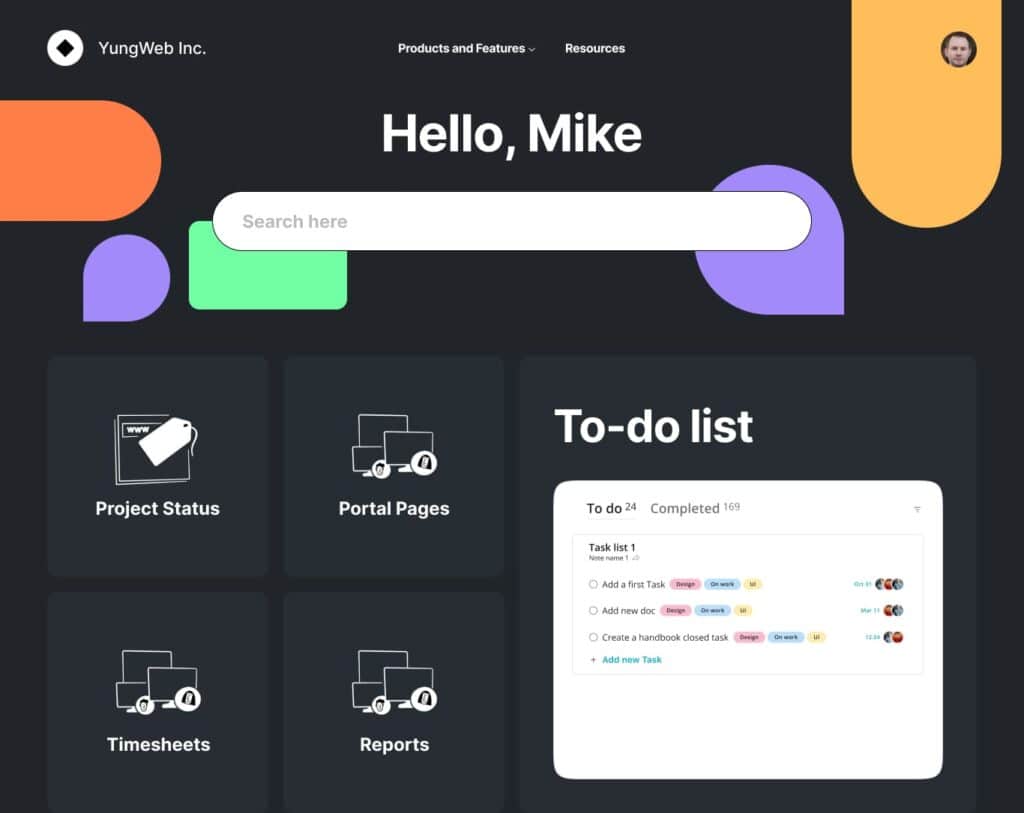
There are several reasons why you might need to implement one of the best client portal software for your business. So let’s take a quick look at some situations in which your business can benefit from having a dedicated, private space for each of your customers:
If you find yourself thinking about and wishing for some of the observations above and many more, you definitely need to start using a client portal software.
There are several benefits to having a client portal, which we can summarize into:
Let’s just say that with a great customer portal, your clients will be in awe of your client wizarding skills! Remember, you’re a wizard, Harry!
A customer portal should include several key features to ensure an optimal customer experience, including:
Basically, a client portal is like the Room of Requirements. If you’re a Harry Potter buff like us, you know what we mean. (wink, wink!)
As you must know by now (if you’ve been paying attention to this awesome article!), having a robust and user-friendly customer portal can streamline communication, enhance customer engagement, and improve the overall customer experience. But with so many options available, it can be overwhelming to choose the right one. So to help make your decision easier, we've compiled a list of the best client portal software to use in 2023 based on key features, user experience, and customer reviews, where we’ve included some big, industry-standard players and some new rising stars in the field. Whether you're looking to increase efficiency, improve customer satisfaction, or gain valuable insights into customer behavior, these client portal software options are sure to meet your needs.
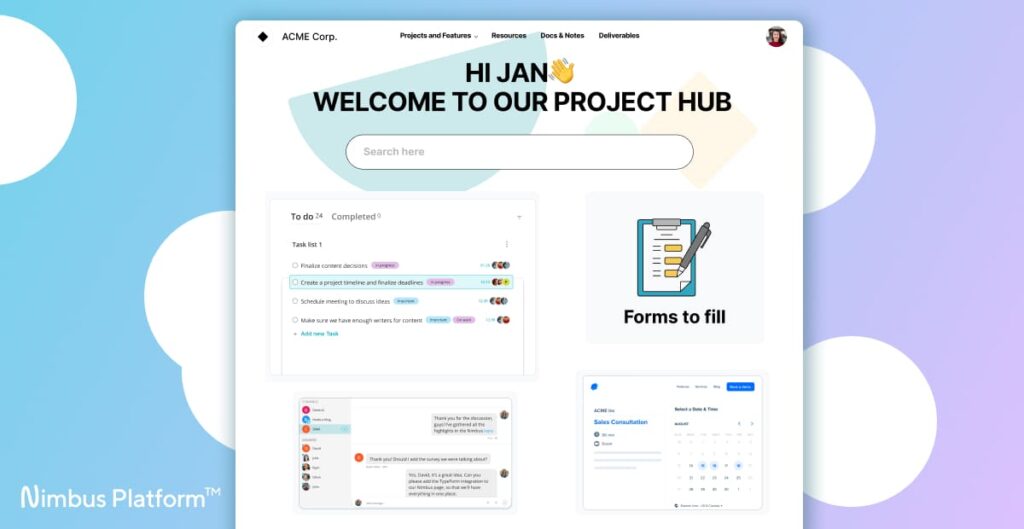
Nimbus Platform is an all-round solution for content management and customer support. With this client portal software, you can create client portals and support documents (knowledge bases), chat and send messages to your customers in real time, answer their support requests, take screenshots and screen recordings with Nimbus Capture and save and organize web content thanks to Nimbus Clipper. This robust solution is perfect for creating bespoke customer portals at a very affordable pricing point.
Pros:
Cons:
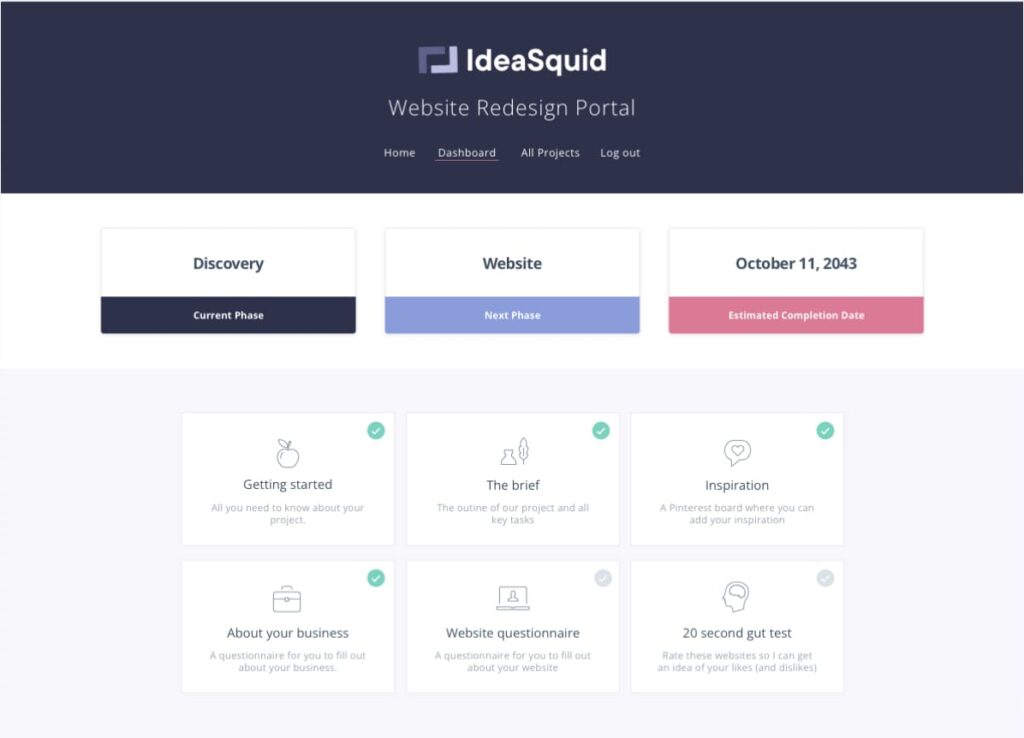
Client-portal.io is an intuitive, easy-to-use WordPress plugin designed to help you create a dedicated client portal within your own website. It offers a range of features to create a secure dashboard where your clients can access whatever you choose: purchase details and downloads, customer data, customer requests, self-service resources, brand assets, payment details and invoices, etc. As it is WordPress based, it is a really flexible and customizable solution to create customer portals.
Pros:
Cons:
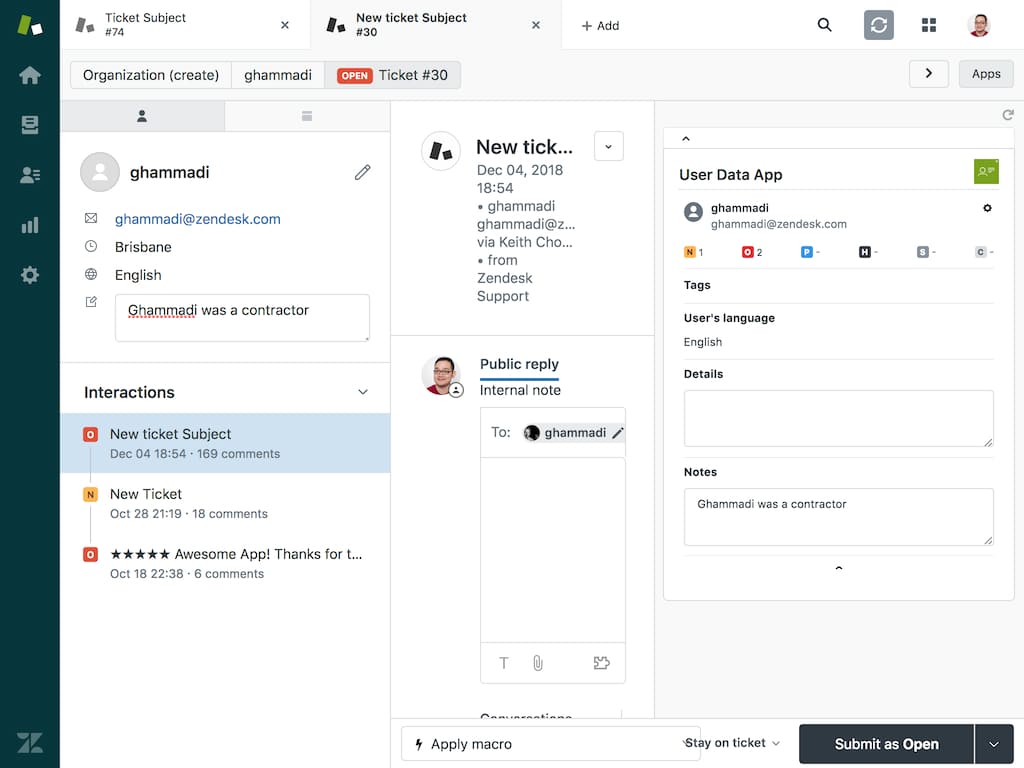
Zendesk is a customer service and support platform that provides a full-blown helpdesk solution with tools that can be tailored to meet the unique needs of any organization. Among other things, Zendesk allows you to build customizable customer portals, robust knowledge bases, online community forums, etc. This client portal software also includes live chat functionality, making it easy for customers to get in touch with support teams. Additionally, Zendesk integrates with a wide range of popular business applications, such as Salesforce and Google Analytics, which enables organizations to streamline their customer service operations.
Pros:
Cons:
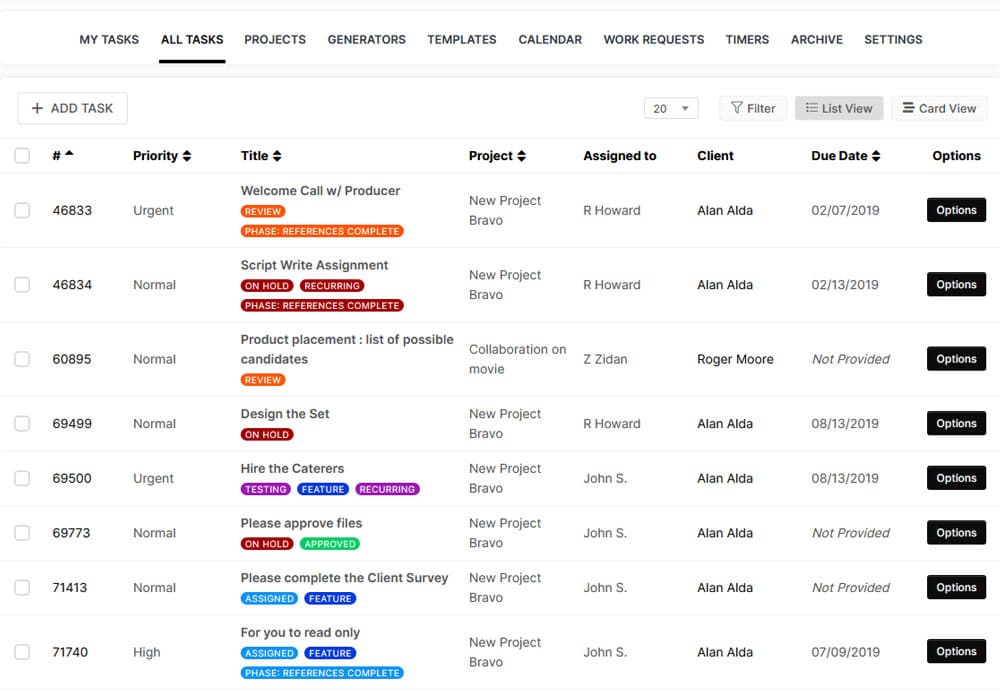
SuiteDash is an all-in-one solution for businesses that need to manage their customer relations, client communications, project management, and invoicing. This client portal lets you customize the look and feel of their customer interactions, so it matches yours or your customer’s brand, restrict customer access, as well as delegate responsibilities and monitor progress through clear reporting and tracking systems.
Pros:
Cons:
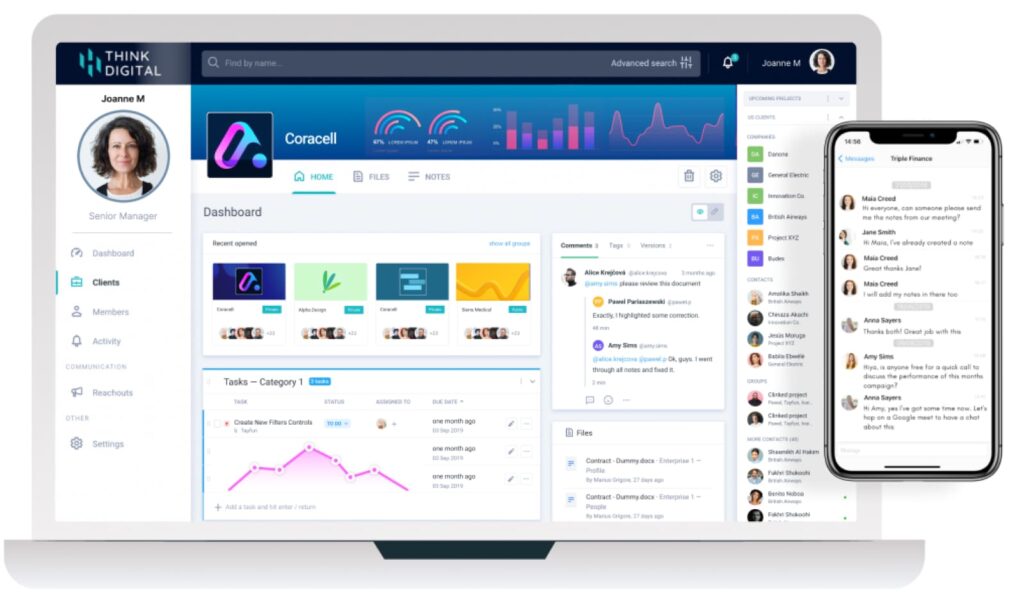
Clinked is a cloud-based all-in-one collaboration platform that helps teams, project groups, and business clients work more efficiently. This client portal software offers secure file storage, sharing, and management, customizable branding features, mobile access, powerful search, integrated messaging, and task management tools. Its users claim that it’s easy to use and perfect for businesses of all sizes, allowing internal teams to collaborate effectively and solve customer queries efficiently with its secure environment and self-service options.
Pros:
Cons:
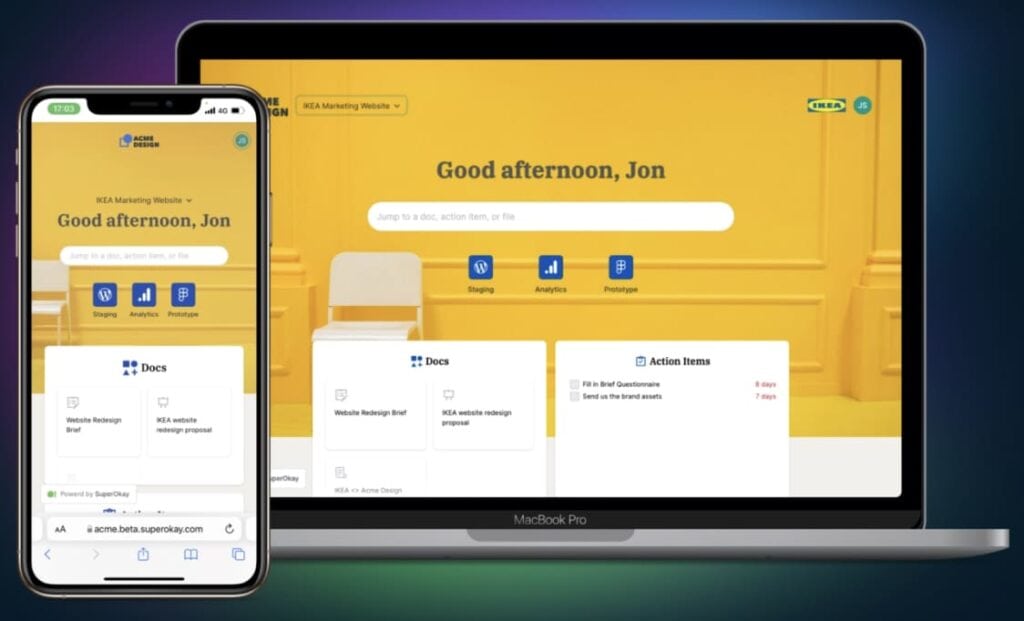
SuperOkay is a relatively new platform designed to help digital agencies, software studios, and freelancers better manage their clients. It offers a customizable client portal interface where internal users can share project links, assets, connected apps, and more. The platform also helps users to increase their efficiency by providing an easy-to-use and unified client portal experience.
Pros:
Cons:

Freshdesk is one of the most prominent customer support platforms and client portal software on the market, and is part of a larger platform called Freshworks. Freshdesk is a cloud-based customer support software that provides businesses with the ability to manage their customer service, including the creation of client and customer support portals. With multiple support channels available, Freshdesk provides a comprehensive suite of features designed to help businesses quickly and efficiently handle customer inquiries.
Pros:
Cons:
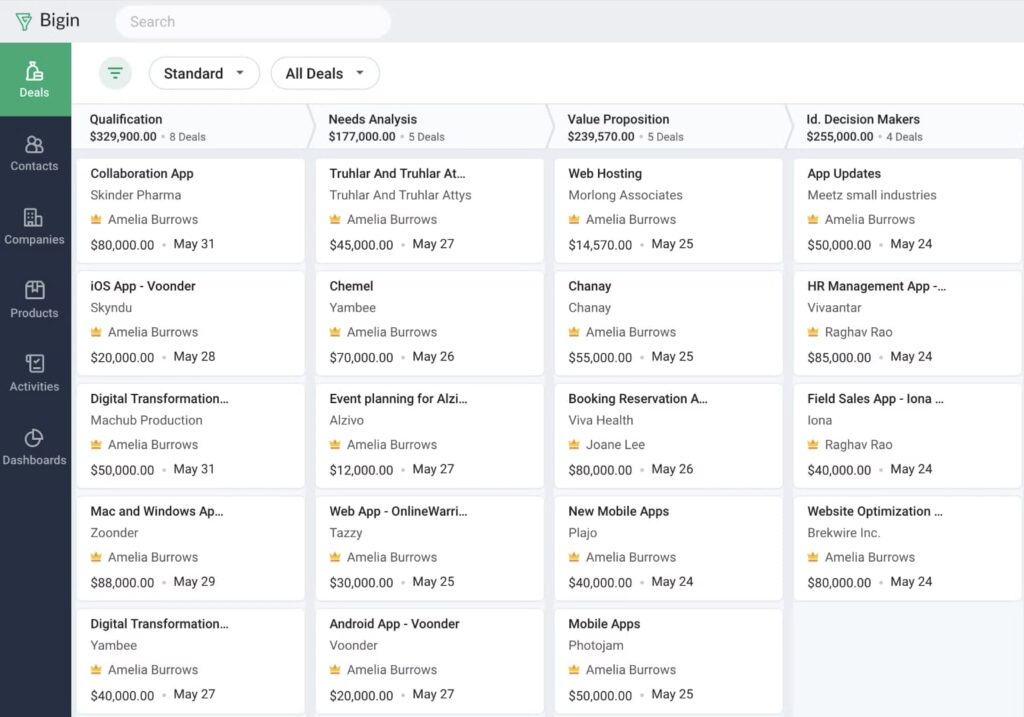
Zoho CRM is an online Sales CRM software that helps businesses of all sizes build excellent customer relationships and manage their sales, marketing and support in one single repository. This CRM software also acts as a client portal software, allowing you to create client portals, especially focused on client and sales management. Due to its range of features, Zoho CRM can be a great tool for businesses looking to maximize their customer relationships and increase sales. However, it might not be the best option for you if you’re simply looking for a client portal solution.
Pros:
Cons:
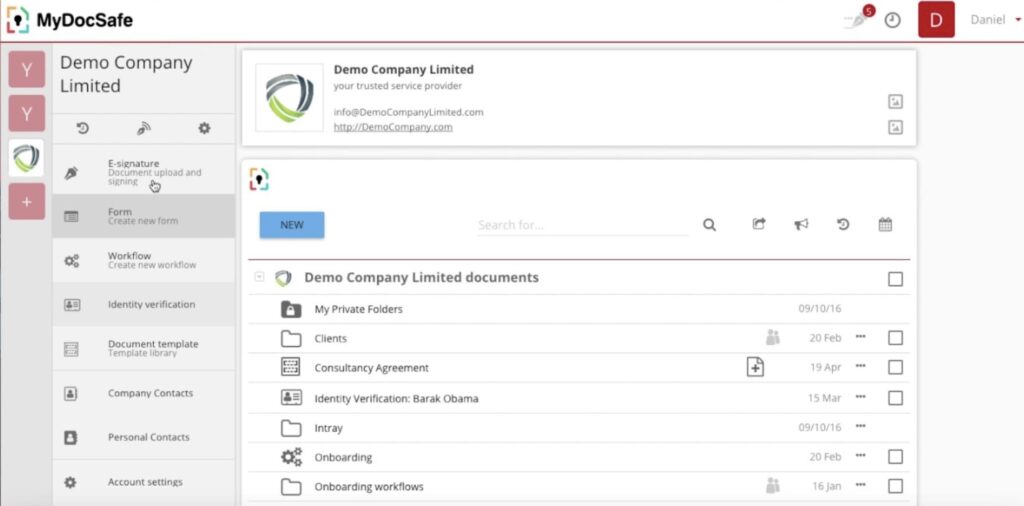
MyDocSafe is a secure and comprehensive digital document security and e-signature platform designed for businesses of all sizes. This client portal software enables companies to design and deploy their own client onboarding processes, virtual data rooms, automated forms, client portals, file requests, etc. This client portal solution helps businesses to quickly onboard customers with a personalized experience, focusing on security measures, e-signature and approval processes.
Pros:
Cons:
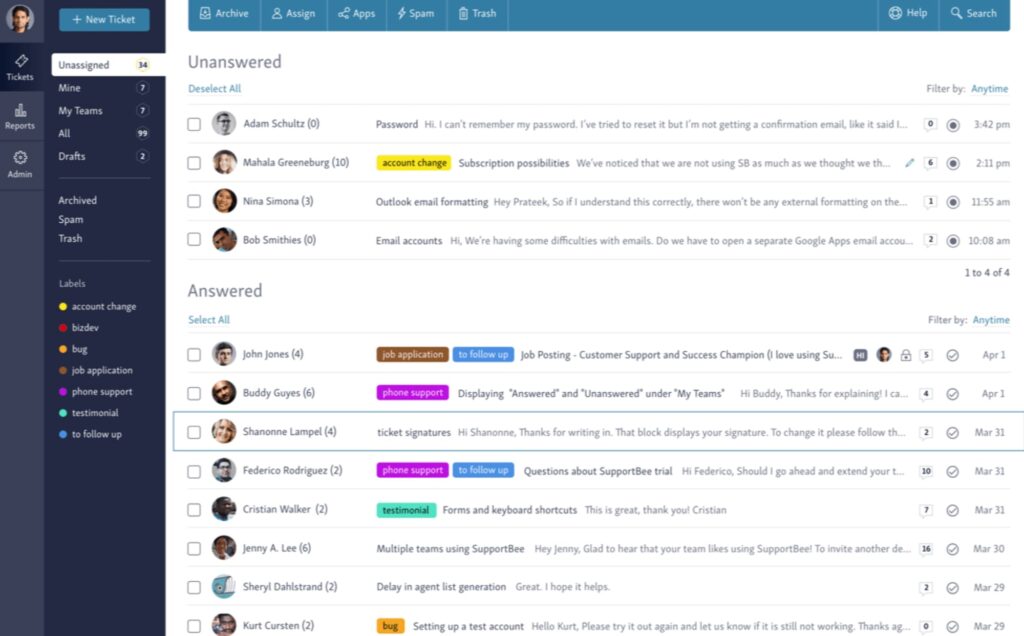
SupportBee is an innovative web-based email support tool designed to help small businesses streamline their customer service efforts. It offers an easy-to-use ticketing system that enables support agents to prioritize, collaborate and organize customer support emails. This customer portal software also allows you to create client portals focused on support tickets and communication, delivering friendly customer service with greater efficiency. The only major issue with Supportbee’s client portals is that they are entirely focused on support tickets and nothing else, so if you need customer portals for other purposes, this might not be for you.
Pros:
Cons:
When choosing a customer portal software, there are several factors to consider, especially the following:
We are sure that one of the client portal softwares provided in this article will fit your business needs, but if you ask us, you’ll be happiest with Nimbus Platform.
If you’re looking for a comprehensive project management tool on your own domain that allows you to manage content, create knowledge bases, store and share files securely, manage tasks, communicate in real time with clients, collaborate with clients and staff, and many other things, well, stop looking, because you’ve already found us!
With Nimbus, you can create the best client portals, completely branded by customizing all the look and feel, embedding widgets, choosing what your clients can do and see on it, etc.
Create an account today and set up your online portal in minutes!
Oroginally it was posted here Nimbus Blog.
Follow Nimbus Platform on Facebook for the latest articles and updates!
Project management is a crucial aspect of any successful business or organization. It involves coordinating resources, delegating tasks, and tracking progress to ensure that projects are completed on time, within budget, and according to the desired quality standards.
One type of project management software that has gained popularity in recent years is a project management (PM) tool with a client portal. This type of software integrates a client-facing hub into its platform, enabling project managers and clients to communicate and collaborate more effectively. The project management client portal allows clients to view project information and leave feedback on it in a secure and organized location.
In this article, we will explore the benefits of using project organization and administration software with client portals, scrutinize their key features, and delve into the best practices for using this type of software. We will also look into the best project management software on the market today. Whether you are a project manager or just someone interested in improving your project management skills, this article is for you.
Project management software comprises tools that help individuals and organizations plan, execute, and track work effectively and efficiently. It typically includes features such as task and resource allocation, time tracking, budget management, and collaboration tools to help managers, team leaders, and teams work together towards company goals.
PM tools have gained popularity with the advancement of the project-based approach and became indispensable for the Information Technology industry. IT projects are complex and require coordination and collaboration between various stakeholders, which makes project management software with client portals an ideal solution for the IT industry. All in all, the use of PM tools has become essential for teams looking to stay competitive in today's fast-paced business environment.
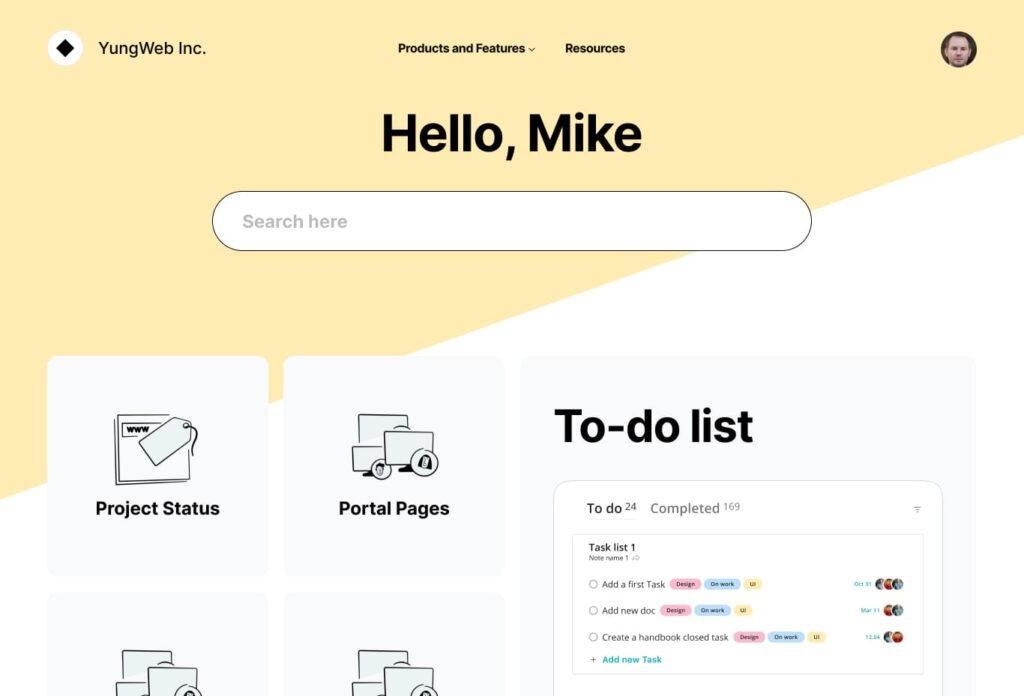
Project management software typically includes a variety of features to help individuals and organizations plan, execute, and track a project's lifecycle. Here are some of the key features to look for in project management software tools:
A task assignment and management system allows PMs to assign tasks, set deadlines, and track progress.
This feature allows managers to allocate resources, such as personnel, equipment, and materials, to specific tasks and projects.
PM tools often include time management tools to help managers track the amount of time spent on each task and project.
This feature helps employers to track expenses and ensure that projects are completed within budget.
Project management software often includes collaboration tools, such as chat, email, and file sharing, to help PMs and team members communicate and collaborate effectively.
Gantt charts are a visual representation of timelines and task dependencies and are often included in project management software tools.
PM software typically includes reporting and analytics tools to help managers track the advancement, identify potential roadblocks, and make data-driven decisions.
Not all PM tools include client portal software, which is extremely handy as it enables clients to access project information and provide feedback. Collaboratively utilizing management software with clients can lead to improved efficiency. Additionally, client portals significantly simplify the client onboarding process, the management of client projects, and sharing of clients’ files. Thus, it is important to invite clients to participate in the project management process through a client portal, as it leads to enhanced productivity and seamless communication between all parties involved.
These are just a few of the key features to consider when choosing project management software. The specific features you need will depend on your particular needs and the size and complexity of your tasks. It is important to take PM tools seriously, as they can have a significant impact on business growth.
Choosing the right project management tool for your organization can be a complex process, but it is essential to ensure that the chosen tool meets your specific needs and helps you manage the operations most effectively. Here are some of the key criteria to consider when choosing project management software:
Project Requirements: Consider the needs of your projects and ensure that the software you choose includes the features and tools you need to manage teams successfully.
User Experience: Look for a software solution with an intuitive and simple user interface to reduce the learning curve and guarantee user adoption.
Integration Capabilities: Consider whether the software integrates with other third-party apps and platforms you use, such as email, chat, and file-sharing tools.
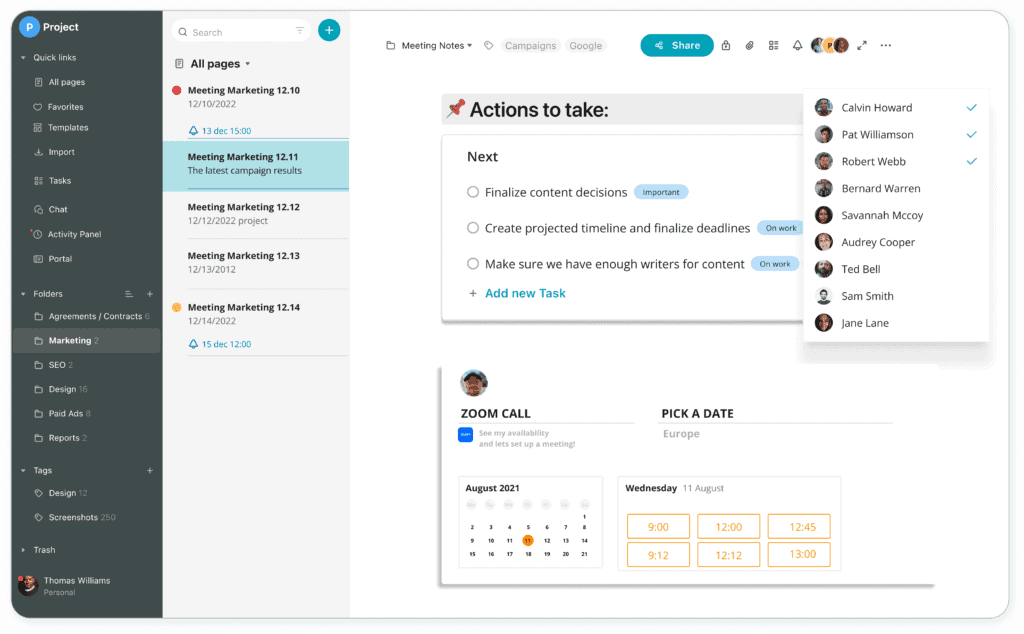
Scalability: Choose software that can grow with your organization and can accommodate an increasing number of projects and users.
Cost: Consider the cost of the software, including any recurring fees and possible extra costs, and ensure that it fits within your budget.
Security: Ensure that the software includes robust security features to protect sensitive information and data.
Support: Look for solutions with a strong support team to help you resolve any issues or answer any questions you may have.
Reviews and Recommendations: Read reviews and ask for recommendations from other project managers and organizations to get a better understanding of the software's capabilities and limitations.
By considering these criteria and weighing the pros and cons of each software option, you can make an informed decision and choose the project management software that best fits your organization's needs.
Project management tools can provide a wide range of benefits to individuals and organizations, including:
Project management software helps individuals and organizations to stay organized by providing a centralized location for project information, task lists, and calendars.
Project management software can automate many manual tasks, such as time tracking and resource allocation, to help teams work more efficiently toward their business objectives.
Collaboration tools, such as chats and file sharing, including in project management software make it easier for the entire team to communicate and work together effectively.
PM tools provide managers, team leads, and other stakeholders with real-time visibility into project development, making it easier to identify potential pitfalls and reasons for project delays and thus make data-driven decisions.
PM software can reduce the risk of human error by automating tasks and providing real-time data and analytics.
Project management tools help managers allocate resources more effectively and ensure that tasks are completed on time and within budget.
A client portal integrated into project management software can enhance communication and provide a clear view of information for clients, leading to improved customer experience, nurturing more loyal customers, and attracting new clients.
Project management software provides detailed reports and analytics to help project managers track project progress and make data-driven decisions.
By using project management software tools, individuals, and organizations can streamline work management processes, improve team collaboration and efficiency, and ultimately, deliver results more effectively and efficiently.
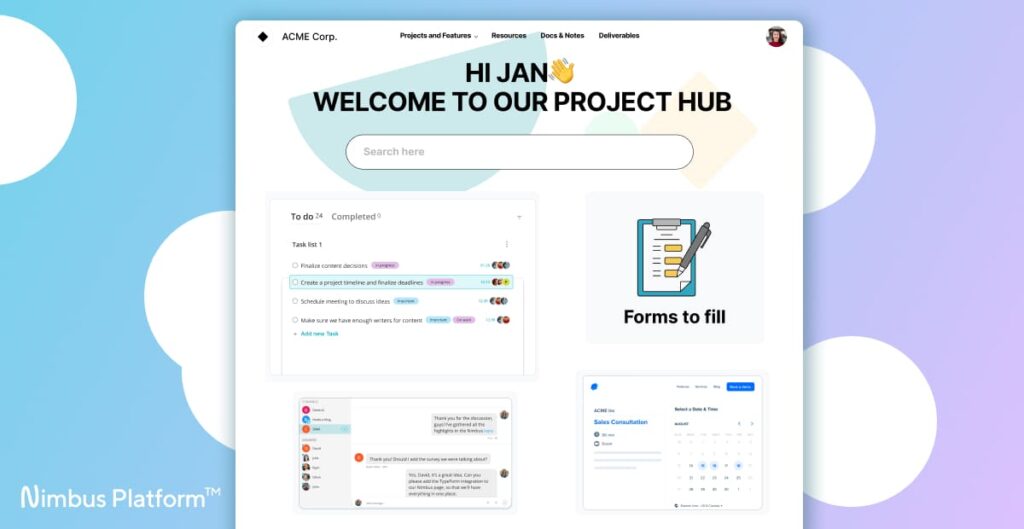
Nimbus Platform is a comprehensive project management tool that offers a suite of features to manage projects in the most efficient way. It incorporates an intuitive task management system with a simple user interface and collaboration tools such as chat, digital file sharing, commenting, and customizable workflows. The Nimbus Note mini tool allows users to quickly and easily create online notes, docs, and wikis, add comments and embed links to them. Nimbus also includes a time-tracking feature and a client portal for secure and organized access to project and client information, progress tracking, and feedback. The platform integrates with other tools like Google Drive, Slack, and Trello. Nimbus's client portal offers a secure and organized platform for teams to manage clients, allowing them to access project information, upload files, keep track of progress, and receive feedback. Whether for small projects or large teams, Nimbus provides all the necessary tools to manage projects with ease.
Manage projects via Nimbus Client Portals
Nimbus Platform pricing options
Four pricing plans are available: Free (basic features), Basic ($9.99/user/mo, more features), Professional ($14.99/user/mo, advanced features), and Enterprise (customized, price determined case-by-case). Nimbus offers flexible pricing, which depends on the chosen functionality and the number of users. Please, visit the Nimbus website for the most up-to-date pricing information.
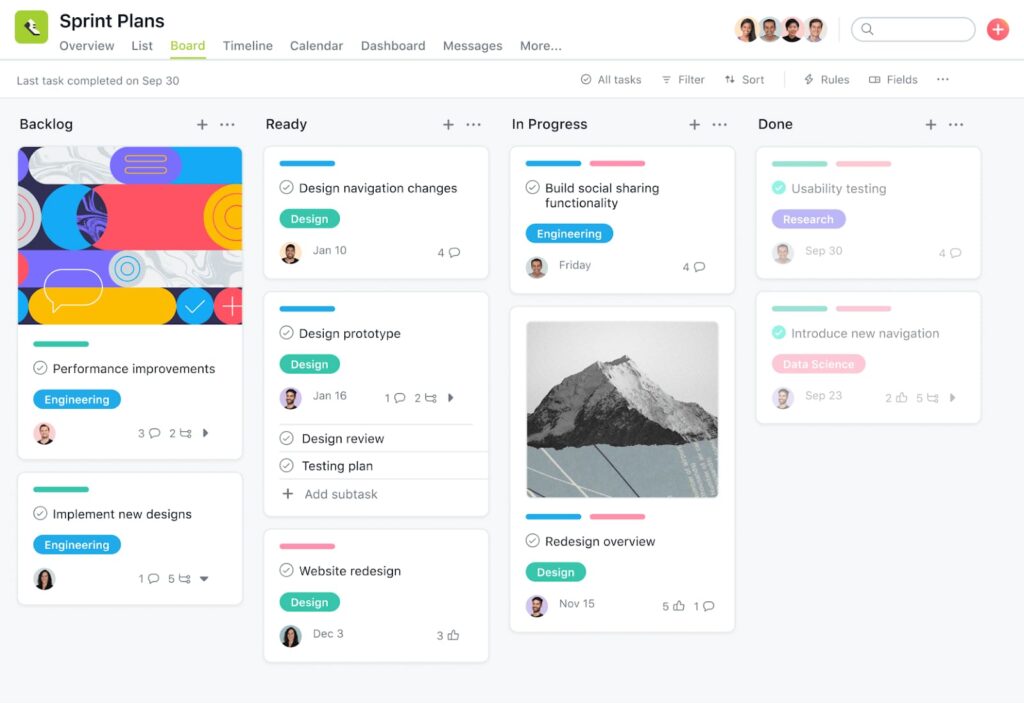
Asana is a project management solution that offers a wide array of features such as a client portal, task management tools, customizable automated workflows, Kanban boards, time tracking, and integrations with other tools like Google Drive, Slack, and Trello. It provides a centralized location for managing tasks, enables effective teamwork through chat, file sharing, and comments, and allows teams to tailor the software to their specific needs. The Asana project management software client portal offers a secure place for both individual clients and corporate ones to view project progress and leave feedback. Asana has everything you need to effectively manage teams and achieve business objectives.
Asana pricing options
Asana has four pricing plans: Free (basic features, up to 15 projects), Premium ($10.99/user/mo, advanced features), Business ($24.99/user/mo, advanced reporting), and Enterprise (customized, price determined case-by-case). Annual billing with discounts is also available. We recommend checking the Asana website for the latest pricing.
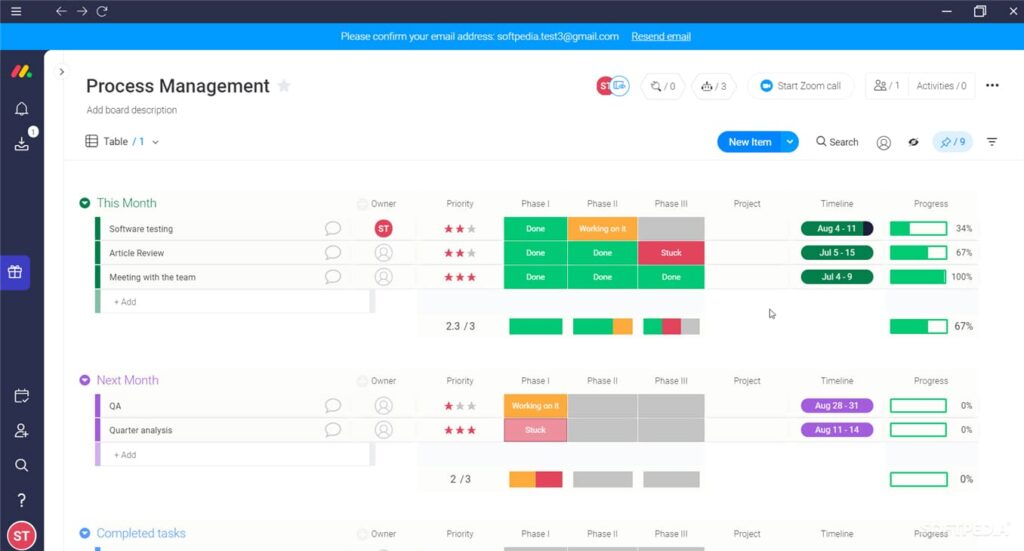
Monday.com is a project management tool that offers a variety of features to enhance project management efficiency and effectiveness. Its centralized task management system with Kanban boards enables teams to keep track of tasks and deadlines and monitor the implementation of the project plan. Collaboration tools are reported to significantly promote teamwork. The software can be easily tailored to the team's specific needs. Monday.com also has a time-tracking feature to monitor tasks and project duration, as well as a client portal software for secure and organized access to project information, progress tracking, and feedback provision. Pre-built integrations with tools such as Google Drive, Slack, and Trello make it easy to integrate into existing workflows. Monday.com client portal provides a secure and organized location for clients to access project information, view progress, share files, and leave feedback, enhancing communication and transparency between teams and clients.
Monday.com pricing options
Monday.com has four pricing plans: Basic ($25/user/mo, essential features), Standard ($39/user/mo, advanced functionality), Pro ($59/user/mo, advanced reporting and integrations), and Enterprise (customized, price determined case-by-case). Monday.com also offers annual billing with discounts. Check their website for the latest pricing.
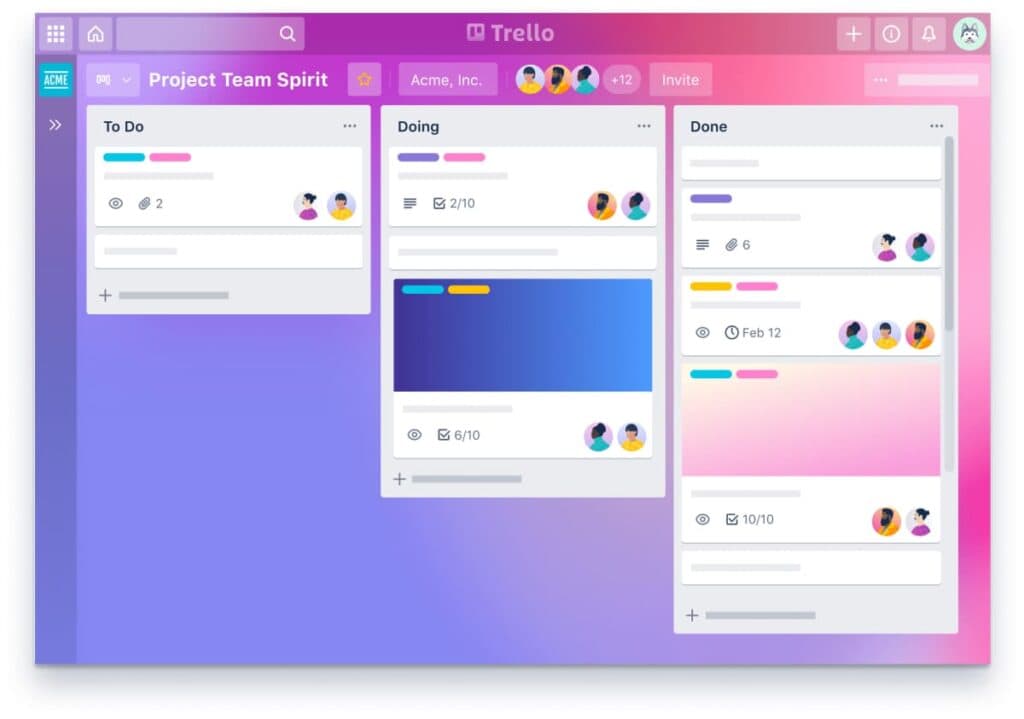
Trello is a well-regarded tool for project management that offers teams an easy-to-use and visual method of organizing and prioritizing project work. It has several key features, including a board-based interface for organizing projects, tasks, and ideas; cards and lists for representing tasks and projects; real-time collaboration via comments, attachments, and due dates; integrations with various tools like Google Drive, Slack, and Jira; a space to track and manage support tickets. Trello's client portal provides a secure and organized location for clients to access project information and provide feedback, making it an effective tool for client communication and collaboration. Trello also boasts a comprehensive client-facing dashboard that provides an in-depth look into project progress and fosters collaboration between all parties involved. The tool is well-suited for any project and team, small or large.
Trello pricing options
Trello offers three pricing plans: Free (basic features), Business Class ($9.99/user/mo, advanced security, and team collaboration), and Enterprise (customized, price determined case-by-case). Trello Enterprise offers a range of advanced features and customization options, including the ability to use a white-label portal, which allows companies to brand the Trello interface with their own logos, colors, and domain names. You can find the most current pricing information on the Trello website.
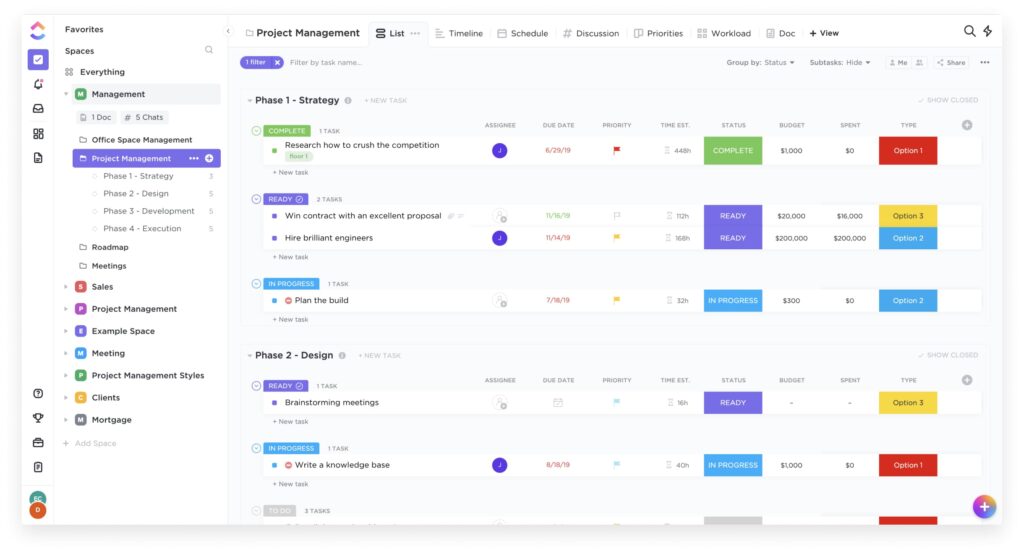
ClickUp is an all-in-one solution that boasts a rich variety of features. Its customizable shareable workspaces allow teams to create a unique environment that fits their specific needs and workflows. ClickUp’s task management features, such as lists, calendars, and customizable dashboards, significantly simplify managing tasks and projects. In the tool, the access privileges of users to the same dashboard can be tailored based on individual roles and project requirements. Collaboration is made seamless with the ability to add comments, attachments, and due dates to tasks, and integration with a wide range of tools such as Google Drive, Slack, and Zapier, ensures smooth integration with existing workflows and processes. ClickUp's client portal feature is also worth mentioning as it provides clients with a means to stay informed about the progress of their projects.
ClickUp pricing options
ClickUp offers pricing plans for different user types:
Check the ClickUp website for updated pricing info.
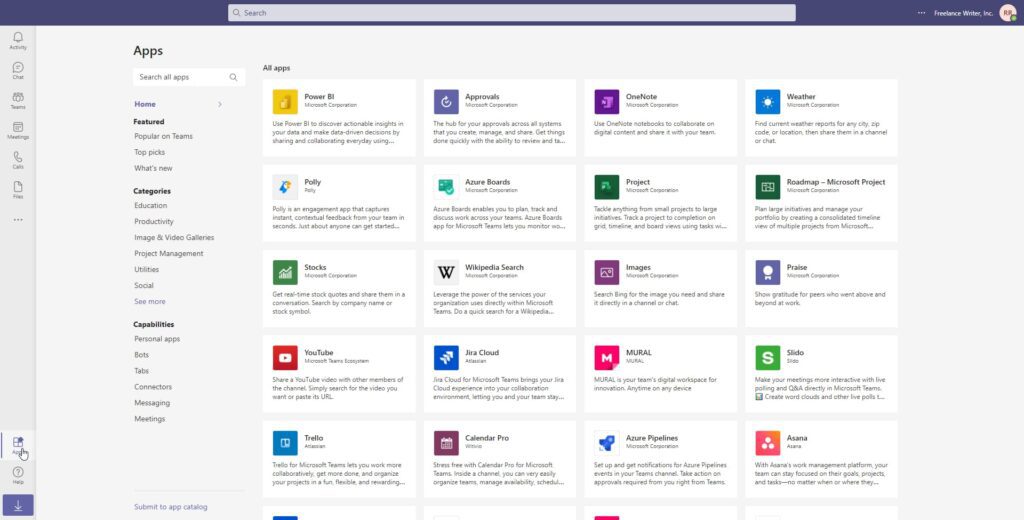
Microsoft Teams is an all-in-one platform that offers a suite of features for teams to manage projects, tasks, work, and even support tickets. The platform provides real-time team chat, a secure solution for sharing files, and a task management feature for team members to stay on top of what needs to be done. The software integrates well with other Microsoft products, making it an ideal choice for teams that work within the Microsoft ecosystem. Additionally, Microsoft Teams includes a client portal feature, which provides clients with a dedicated platform for accessing project details, updates, and other relevant information, all in an organized and efficient manner. Microsoft Teams users can use their own domain or custom URL for accessing the platform’s services. Whether for small businesses or large enterprises, Microsoft Teams offers a versatile set of tools to manage projects most efficiently.
Microsoft Teams pricing options
The platform offers various pricing options, including a completely free version and multiple paid plans. The free version of Microsoft Teams includes basic features such as team chat and file sharing, while paid plans offer additional features such as task management, integrations, and more. The paid plans vary in price, and it is best to check the company website for the latest pricing information and to determine the best plan for your needs.
Project management tools with client portals are a must-have for businesses looking to improve project collaboration and increase efficiency such as IT companies, marketing agencies, consumer goods corporations, manufacturing organizations, design agencies, etc. Technology has played a vital role in advancing the capabilities of PM software, allowing teams to collaborate in real time, automate repetitive tasks, and access important project information from anywhere. Cooperating using management software with clients has been shown to result in increased efficiency.
Of all the tools mentioned in the article, Nimbus Platform stands out as a comprehensive solution that provides teams with a range of project management and collaboration features, along with client portals. With its user-friendly interface, advanced reporting and customization options, and competitive pricing, Nimbus Platform is a great choice for businesses of all sizes. If you're looking for a powerful and flexible project management tool, we recommend giving Nimbus Platform a try. You can download a free trial to see how it can help you manage your projects and work more efficiently.
Originally it was posted here: Nimbus.
Visit the Nimbus LinkedIn page for the latest news and updates!